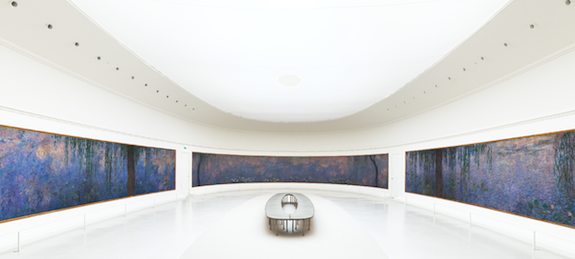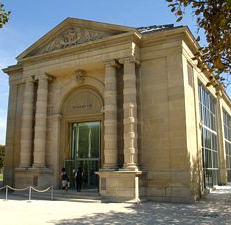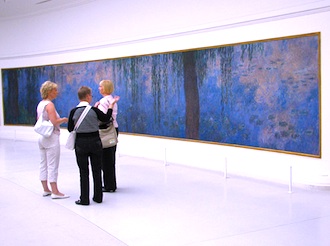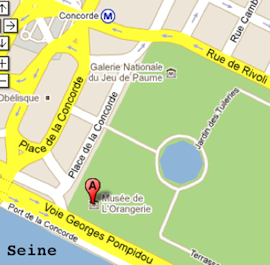Finding Monet at Musee de l’Orangerie

- SUBSCRIBE
- ALREADY SUBSCRIBED?
BECOME A BONJOUR PARIS MEMBER
Gain full access to our collection of over 5,000 articles and bring the City of Light into your life. Just 60 USD per year.
Find out why you should become a member here.
Sign in
Fill in your credentials below.
Coming out of the Concorde Métro station, I looked up and saw a sign pointing more or less across the Place de la Concorde to Musée de l’Orangerie. So, off across the square I started, looking for the next clue that would point me in the direction of the museum—and so hopelessly lost I became. Seeing the Arc de Triomphe looming over trees, I knew I was in the wrong place. I should have remembered not to rely on French signposts and a sense of direction: a block down the street from where I’m staying there is a sign that points due East towards the Parc des Buttes-Chaumont when I know full well that the park lies northwest of that signpost. Apparently, everyone in Paris knows where the Musée de l’Orangerie is—except me.
 I returned to Place de la Concorde and resumed my search, wandering into the Jardin des Tuileries. Unsure what to do, I strayed among the neoclassical sculptures and up stairs to my right in search of a solitary bench among the trees. Finding none, I wandered around the back corner of a long and simple-looking building that was probably used to store materials for the maintenance of the gardens—or so I thought until I saw a stream of tourists coming out the other end. Yes, it was indeed the Musée de l’Orangerie, and the only definite indication of that was in the modest, small lettering above the front entrance that read, quite simply, “Orangerie.”
I returned to Place de la Concorde and resumed my search, wandering into the Jardin des Tuileries. Unsure what to do, I strayed among the neoclassical sculptures and up stairs to my right in search of a solitary bench among the trees. Finding none, I wandered around the back corner of a long and simple-looking building that was probably used to store materials for the maintenance of the gardens—or so I thought until I saw a stream of tourists coming out the other end. Yes, it was indeed the Musée de l’Orangerie, and the only definite indication of that was in the modest, small lettering above the front entrance that read, quite simply, “Orangerie.”
Second Empire meets acrylic and concrete
 But the renovated Musée de l’Orangerie is nothing if not a tale of transformations, through and through; so much is immediately apparent in the contrast between the meticulously maintained French garden and Second Empire façade outside and the sleek, new acrylic and concrete interior. Immediately in front of the visitor upon entrance to the museum looms a massive concrete block that presumably forms the gallery’s administrative nucleus. After going through a routine security check one passes underneath this block to the ticket booth on the left and the audio guide station on the right. Now, to explore the museum!
But the renovated Musée de l’Orangerie is nothing if not a tale of transformations, through and through; so much is immediately apparent in the contrast between the meticulously maintained French garden and Second Empire façade outside and the sleek, new acrylic and concrete interior. Immediately in front of the visitor upon entrance to the museum looms a massive concrete block that presumably forms the gallery’s administrative nucleus. After going through a routine security check one passes underneath this block to the ticket booth on the left and the audio guide station on the right. Now, to explore the museum!
Renovations took out the entire second level to make space for the new ceilings of the rooms that house Monet’s Les Nymphéas, and let me tell you, space remains. Ahead is another block of concrete that houses Monet’s panoramic paintings, but light streams in from the glass ceiling above and the windows to the side, so the general effect is not of postmodern architectural experimentalism but of clarity and simplicity. The renovations also carved out a basement in which to put the Walter-Guillaume collections, as well as a small space for exhibitions, a small but well-equipped classroom, and an audiovisual room where a film praising the remodeled museum is on a continuous loop. Amusingly, there is more than just art on display here: a section of a 16th-century wall called “les fossés jaunes” that was uncovered during construction was incorporated into the design of the basement and merits its own explanatory plaque.

Seeing the light, finding Monet’s Les Nymphéas
Then, of course, there is Les Nymphéas itself. Upon entering the giant concrete block one passes through a white, minimalist, and domed vestibule with an oculus at the top; presumably this is here to clear the mind for the great work of art that is to follow. And it does the trick; Monet’s masterpieces shine in soft harmony in the natural lighting he intended for them (although, to be brutally fair, the sloping section of the room that lies above the ceiling-like suspended translucent cloth and that allows in the natural light is also augmented by some artificial lighting).

Despite the drastic transformations that have changed the Musée de l’Orangerie during the six years it was in renovation, the finished product is one of light simplicity, harmony, and clarity—just the sort of architecture needed to house the tranquil Nymphéas cycle. The only jarring contrast is with the noisy and harried Place de la Concorde outside.
Take a video tour:
Practical Information
Musée de l’Orangerie
Tél. 01 44 77 80 07
Jardin des Tuileries, Paris 1st
Hours: Open every day except Tuesday, May Day, and Christmas, from 12:30 to 7 (and until 9 on Friday).

Métro: 1, 8, 12, station Concorde
Bus: 24, 42, 52, 72, 73, 84, 94, Concorde stop
Admission: 7.50 € (2011); reduced rates for children, seniors and people with disabilities.
Accessibility: stairs in front; ramp on side after crossing gravel and cobbles. Please call ahead if you’re confined to wheel chair to have a guard open a security door.
Copyrighted photos by Musée de l’Orangerie; entry from Wikipedia; large Nympheas images ©Michel Urtado; walkway by Agence Brochet-Layus-Pueyo and Women by Nymphéas by ©maccosta


